Learning the Five Pentatonic Scale Patterns on Guitar
Ready to spice up your guitar playing? Say hello to the pentatonic scale, a gem that’s powered countless epic solos and might become your new musical best friend.
With its roots in the major scale, this five-note wonder (yep, “penta” means five) simplifies creativity, stripping away two notes from the major scale for a more improvisation-friendly lineup.
What Makes Pentatonic Scales Different from Diatonic Scales?
Ever fear hitting a wrong note during a solo? The pentatonic scale is your safety net. Ditching the fourth and seventh notes of the major scale removes the trickiest intervals, freeing you to explore without hesitation. Whether crafting a melody or shredding a solo, these scales offer a solid foundation with minimal risk of clashing notes.
Navigating the Pentatonic Landscape: Major vs. Minor
There are two primary flavors of the pentatonic scale: major and minor. First up is the major pentatonic scale, which might test your finger flexibility with its varied patterns across the strings. Practice one string at a time to get the hang of it.
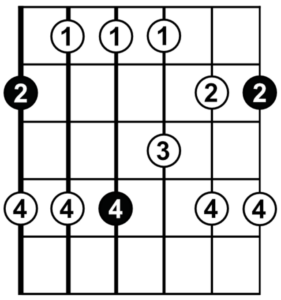
Root notes are your anchors here, guiding you through the scale’s geography. They’re the black dots on diagrams, matching the scale’s name, and they repeat across the fretboard, letting you weave through over two octaves with ease.
Then there’s the minor pentatonic scale – your go-to for those gritty, soulful solos. Its simplicity, with just two patterns to remember, makes it a fast favorite for newbies and seasoned guitarists.

The Five Shapes of Pentatonic Power
Once you’ve dipped your toes into the major and minor pentatonic waters, it’s time to explore all five shapes that span the guitar’s neck. These interconnected patterns offer a roadmap to unleash the full potential of the pentatonic scale across your fretboard.
It’s worth noting that the following pentatonic scale patterns correspond with the chord shapes in the CAGED system.
Pentatonic Shape 1: E Major Chord Shape
Starting with the major pentatonic, the shape is like an E major chord’s shadow, containing all its notes plus some. Visualizing chord shapes alongside scale patterns can dramatically boost your memorization and understanding of root notes.

Pentatonic Shape 2: D Major Chord Shape
This one picks up where Shape 1 left off, tracing the contours of a D major chord. It’s a vivid illustration of how scales and chords are intertwined, enhancing your navigation skills as you shift from one shape to the next.
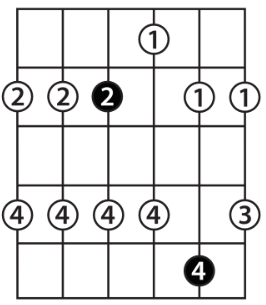
Pentatonic Shape 3: C Major Chord Shape
Moving up, we encounter a shape that mirrors a C major chord. It’s another example of the pentatonic scale’s versatility, repeating the same five notes through different octaves.
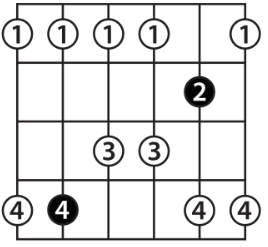
Pentatonic Shape 4: A Major Chord Shape
This shape is easy to grasp and outlines an A major barre chord with just two patterns. It links seamlessly with Shape 3, enriching your fretboard fluency.
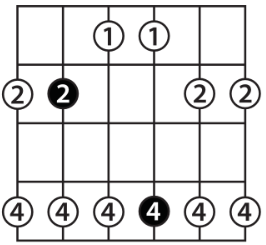
Pentatonic Shape 5: G Major Chord Shape
Finally, the minor pentatonic shape slots in as the last piece of the puzzle, with a G major chord at its heart. It’s a full-circle moment, connecting back to the scale’s dual nature.
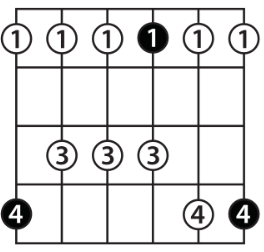
Major Meets Minor: The Theory Behind the Magic
Understanding the relationship between major and minor keys is crucial, especially if music theory feels like foreign territory. Every major key has a relative minor, sharing the same notes but starting from the major scale’s sixth degree. This concept is a cornerstone of the pentatonic scale, linking major and minor shapes through shared notes and chords.
For instance, in C major:
C Major Scale: C D E F G A B C
The sixth note of the C major scale is A, the relative minor. This leaves us with:
A Minor Scale: A B C D E F G A
This relationship ensures that your five major pentatonic shapes double as minor pentatonic maps simply by shifting the root note perspective.
Check out our article about moveable major scale patterns to sharpen your grasp of the fundamentals of diatonic harmony!
Breaking Free From the Pentatonic Box
For many guitarists, the pentatonic scale is like a comfortable old friend. Its familiar patterns and reliable sound have laid the foundation for countless solos across various genres.
However, relying solely on the pentatonic scale can often lead to stagnation or limitation in one’s playing. Breaking free from the pentatonic box opens up a world of creative possibilities and allows guitarists to express themselves in new and exciting ways.
Check out this video from Green Hills Guitar Studio instructor Sam Farkas for a great exercise on how to break out of this useful but well-worn pentatonic box pattern.
The Coda
Armed with knowledge of both major and minor pentatonic shapes, you’re now poised to dive deeper into lead guitar. This guide is just the beginning—a whole universe of scales, techniques, and styles is waiting for you. Keep exploring, and let the pentatonic scale be the key to unlocking your full musical potential.
Interested in Taking Guitar Lessons in Nashville or Online?
Ready to elevate your guitar skills and unlock your musical potential? If you’re interested in private lessons from a pro, reach out to book guitar lessons in Nashville, TN, or online.






